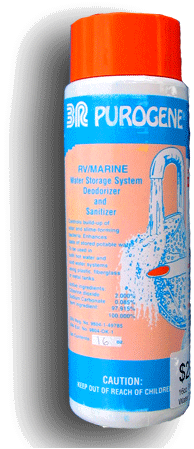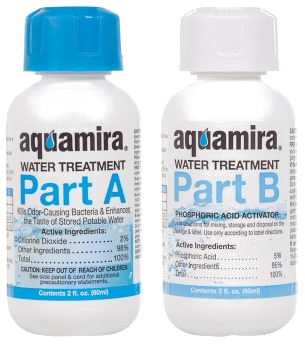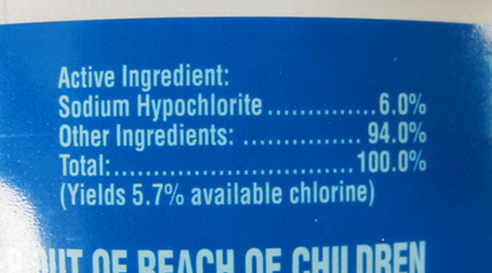How to make and keep water safe
Researched in August, 2014
There are a number of methods to consider. (We may not cover filtering in this
document.)
- Boiling
- Other chemical methods
- Household bleach
- Physical filtering
Boiling
Boiling is the surest method to make water safe to drink and kill
disease-causing microorganisms like giardia lamblia and
cryptosporidium, which are frequently found in rivers and lakes.
Boiling does nothing for the water's taste, however. To improve that, you can
pour the water back and forth between (clean) containers to ærate it.
There are other ways to ærate it. You can also add small amounts of salt
to it.
Boiling is often not practical for more than tiny quantities.
Purification using commercial treatments

|
The best and least expensive commercial product I've found is
Purogene®. It is chlorine dioxide and imparts no unpleasant
taste or odor unlike sodium hypochlorite or straight chlorine. I
purchased a 32-ounce bottle of this product, enough to do 960 gallons, for
about $50 including shipping from
Baytec Containers.
The company says it is good for a long time, but doesn't say how long. Since it
uses the same active ingredient as Aquamira®, I assume at least 5 years.
It's also as easy or easier to use than household bleach.
|

|
Aquamira® is a two-part treatment that protects containers of water against
bacterial growth up to 5 years. The treatment consists of a mild acid,
phosphoric acid, and an alkaline, chloring dioxide. The latter acts like
bleach, the former acts presumably to neutralize the taste effects of the
latter. It appears to be a good system. However, as sold by Emergency
Essentials, it will cost me $135 to set up 9 barrels.
|
Purification using "pool shock"
"Pool shock" refers to crystals sold to condition swimming pools with and that
contain chlorine. These can be used and are relatively inexpensive. The United
States Environmental Protection Agency (EPA) seems to think so; it recommends
the following procedure, copied from the web:
Add and dissolve one heaping teaspoon of high-test granular calcium
hypochlorite (approximately ¼ ounce) for each two gallons of water,
or 5 milliliters (approximately 7 grams) per 7.5 liters of water.
The mixture will produce a stock chlorine solution of approximately 500
milligrams per liter, since the calcium hypochlorite has available
chlorine equal to 70 percent of its weight. To disinfect water, add the
chlorine solution in the ratio of one part of chlorine solution to each 100
parts of water to be treated. This is roughly equal to adding 1 pint (16
ounces) of stock chlorine to each 12.5 gallons of water or (approximately
½ liter to 50 liters of water) to be disinfected.
To remove any objectionable chlorine odor, ærate the disinfected water by
pouring it back and forth from one clean container to another.
Purification using household bleach
Companies will assure you that you must not use household bleach to make and
keep your water safe to drink. There is truth to this and there is fallacy.
What's true...
Some bleach you purchase in the grocery store has other things besides chlorine
bleach. If the bleach has perfumes or detergent (soap) additives, those will
not be good to put into your barrels.
Also, you must be sensitive to the dose of chlorine bleach to water. If you
don't know these, don't have a way to be accurate about it, then you can't feel
safe about what you're doing.
What's not true...
What's not true is that you have to spend a lot of money to make water safe to
drink.
On this page, I will not recommend using household bleach and I will not say
that it works just as well or better than more expensives products like
Purogene or Aquamira.
My purpose is only to explain how to use household bleach if you decide to do
so. I have taken my information from research done on the web. It's all
plagierized; I am not a chemist, trained or otherwise.
Is household chlorine bleach safe and effective?
The United States Environmental Protection Agency (EPA) seems to think so.
Please see their publication on the
Emergency Disinfection of Drinking Water. One of the methods they
recommend is precisely the one we're discussing here.
How to use household bleach
One thing you may already have guessed as to where this is going...
Doesn't this dosage depend on the concentration of chlorine in the store-bought
bleach? Yes, it does. You should look for a product label like the one in the
illustration below, 6% sodium hypochlorite or 5.7% chlorine. It's from a
bottle of Chlorox®. This bottle probably does not contain other things like
soap or perfume.

For dosing it, the best advice I found is also the easiest to remember:
You must be 21 to drink.
This is a trick of course. It's to help you remember that you need
2 drops of bleach for every
1 liter of water you are trying to purify.
A 55-gallon barrel, if filled completely, will contain about 209 liters based
on the formula:
3.8 liters / 1 gallon
Drops as a means of measuring is tedious. Here's the dosing table for using
5-6% standard household chlorine bleach (in ascending order of usefulness):
|
2 drops per quart/liter
|
8 drops (1/8th teaspoon) per gallon
|
7 teaspoons per 55-gallon barrel
|
Caveats
- Household bleach, using sodium hydroclorite decays quickly over
time, under conditions of (ultraviolet) light and heat. Do not expect
this treatment to hold for more than one-year. Plan an annual moment you
can remember and have the time to dedicate to the task for draining,
refilling and retreating your barrels. (Or choose the $135 solution that
will last for 5 years.)
- This treatment will not render safe water that contains sediment:
make sure you start with good, pure water.
- This treatment will not preserve water against giardia or
cryptosporidia: make sure you start with good, pure water.
- The shelf life of bleach is somewhat limited. If you keep some for "food
storage," especially for water purification, you'll need to use a greater
quantity the older the bleach is. See the EPA document for cases in which
you're in doubt.
- If you're trying to render water safe to drink on the spot with this
method, wait at least 30 minutes before consuming.
General EPA advice for treating water
- Filter murky or colored water through clean cloths or allow it to settle.
It is better to both settle and filter.
- Boiling is the surest method to make water safe to drink and kill
disease-causing microorganisms like giardia lamblia and
cryptosporidium, which are frequently found in rivers and lakes.
- To improve the flat taste of boiled water, ærate it by pouring it
back and forth from one container to another and allow it to stand for a
few hours, or add a pinch of salt for each quart or liter of water boiled.
- When boiling is not practical, certain chemicals will kill most harmful or
disease-causing organisms. Chlorine (in the form of unscented bleach) and
iodine are the two chemicals commonly used to treat water.
- You can use a non-scented, household chlorine bleach that contains a
chlorine compound to disinfect water. (Remember, 1/8 teaspoon and 8 drops
are about the same quantity.)
- You can use tincture of iodine to disinfect filtered and settled water.
Common household iodine from the medicine chest or first aid kit may be
used to disinfect water.
- Tincture of iodine. For cloudy water add ten drops and let the solution
stand for at least 30 minutes.
DryTec® calcium hypoclorite purification table
Much of the following content is copyright © 2015 by Jungle Outfitters
and used by permission. ppm stands for "parts per million."
| Desired ppm |
5 gallons |
55 gallons |
275 gallons |
5lbs CHC purifies: |
Use |
|---|
| 10 ppm |
0.29 grams |
3.2 grams |
16 grams |
38,969 gallons |
(heavy contamination) |
| 5 ppm |
0.15 grams |
1.6 grams |
8 grams |
77,938 gallons |
(moderate contamination) |
| 1 ppm |
0.03 grams |
0.32 grams |
1.6 grams |
389,688 gallons |
(municipal tap water) |
By measuring spoon and weight
| 1/16 tsp |
0.29 grams |
| 1/8 tsp |
0.57 grams |
| 1/4 tsp |
1.14 grams |
| 1/2 tsp |
2.28 grams |
| 1 tsp |
4.56 grams |
| 1/2 tbsp |
6.84 grams |
| 1 tbsp |
13.68 grams |
|
A rule of thumb when purifying using chlorine is to treat water, then let
stand 30 minutes and sniff. There should still be a faint odor of chlorine.
If not, this is a sign that the chlorine has been consumed in doing its
job and you need a little more. Retreat and resniff.
WARNING: Before consumption, residual chlorine must be less than 4 ppm.
This is an EPA recommendation. Once it has worked its purification, residual
chlorine can be removed by running through a carbon filter, adding lemon juice
or leaving uncovered to "gas off" for 24 hours.
|


